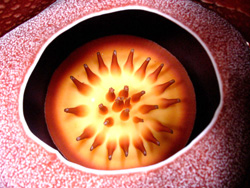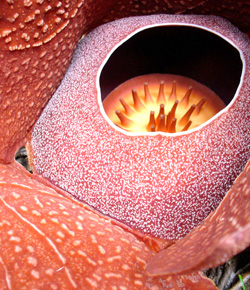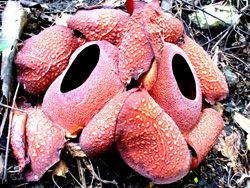Rafflesia Blooms: The world's largest individual flower blooms in Barangay Igcabugao, Igbaras
People around the world make special pilgrimages as far as the rainforests of southeastern Asia hoping to see these extraordinary blossoms

Processes and disk
It is the worlds largest individual flower. Locals call it corpse flower due to the vile smell (like rotting meat) it gives off. Its diameter can grow to over 100 centimeters and can weigh up to 10 kilograms. Even its smallest flower specie (the ones commonly found in the Philippines) measures 20 centimeters in diameter. It has a lifespan of 5-7 days.
Rafflesia, is a genus of parasitic flowering plants having five petals but has no stem, leaves or true roots. It is a parasite that attaches itself to a host plant, a vine they call Tetrastigma (a relative of a grape), and grows only in undisturbed rainforests, to obtain water and nutrients. The flower occasionally breaks through the bark as a huge bud and expands into a huge blossom. Unless one sees evidence of an old blossom, you could walk right past a Tetrastigma vine without ever knowing that a complete Rafflesia plant lives inside its stem.

The warts or white spots
The flower was discovered by an Indonesian guide and named it after the leader of the expedition, Sir Thomas Stamford Raffles (adventurer and founder of British colony Singapore) in one of the rainforest in Indonesia in 1818. It has 17 species all found in southeastern Asia, and in the Philippines, its genus arnoldii, named after a botanist, Joseph Arnold, is the most common growing Rafflesia in identified areas. Its vividly-hued lobes bordered the flowers broad circular basin. Numerous depressions marked the upper surface of its diaphragm with pure-white spots on the lower surface of the diaphragm. Further down, inside the corolla of petals, are reddish, tentacle-like, branches known as its ramentae and are said to be the source of the Rafflesias odor.
People around the world make special pilgrimages as far as the rainforests of southeastern Asia hoping to see these extraordinary blossoms. But, more often, their mission fall short since these flowers are scattered and hard to reach and with short and unpredictable blooming periods.
For this reason, there is great interest in conserving Rafflesia sites and the simplest and most obvious way to conserving it is by preserving its habitat. Cultivating it could save this endangered specie.

Twin Rafflesia blooms
Maintaining a Rafflesia habitat is an outstanding tourism potential for the rural folks. It causes ecotourism as many people go to identified areas annually hoping to see it bloom. Though not relatively abundant, Ilonggos can now view Rafflesia through a 30-minute mountain hike in the rural village of Barangay Igcabugao, one of the 46 barangays of Igbaras, a fourth-class town south in the province and 40-kilometers away from the city.
However, a variety of factors may impede the development of such habitat like poor roads in the area, uncertainty in the protection of natural resources, illegal activities degrading the site and security problems. Tourism is now developing with visitors to the area, aside from a trek to the habitat, there is some jungle trekking to the waterfalls and caves along the barangay. With that, it will be possible to encourage tourists whose visits will help pay to preserve Rafflesias habitat, rather than destroy them. The next few years will determine whether here, and elsewhere, more species probably will be found.
Barangay Igcabugao has an accommodation---a visitor centre with guides, and a campground with shelter. Despite its popularity as an identified destination site, local tourists have not yet degraded the area. The local government of Igbaras headed by its very active, tourism-oriented municipal mayor, Hon. Jaime E. Esmeralda, is all out to develop ecotourism for Igbaras. The town contains some of Iloilos richest series of exceptionally beautiful forested mountains, from lowlands to highlands, large enough to preserve the integrity of the towns ecosystem.
Igbarasnons can now have a lasting influence and be remembered by people everywhere for their commitment to nature and its protection, and future conservation work that will help protect their habitat for the wonder of future generations. This vision is a future where the towns magnificent natural heritage is preserved, protected, explored and adored by many Ilonggos and for generations to come.
Updated February 11, 2008, Iloilo City, Philippineshttp://www.thenewstoday.info/2008/02/11/rafflesia.blooms.html


Tidak ada komentar:
Posting Komentar